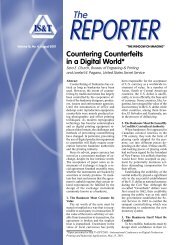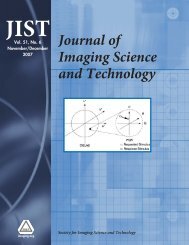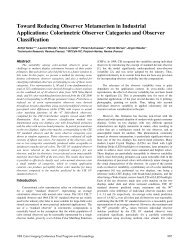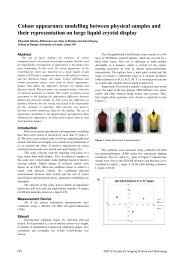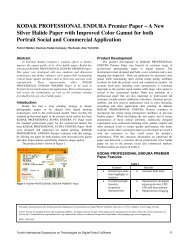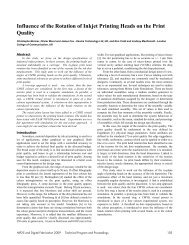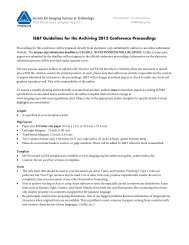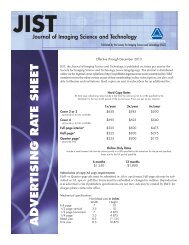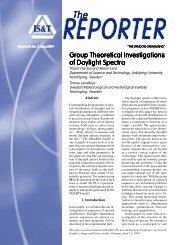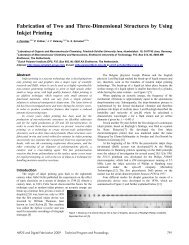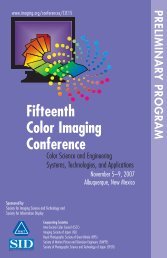JIST - Society for Imaging Science and Technology
JIST - Society for Imaging Science and Technology
JIST - Society for Imaging Science and Technology
You also want an ePaper? Increase the reach of your titles
YUMPU automatically turns print PDFs into web optimized ePapers that Google loves.
Chang <strong>and</strong> Chao: Preparation of microemulsion based disperse dye inks <strong>for</strong> thermal bubble ink jet printing<br />
Yellow 77 had better compatibility with other ingredients to<br />
achieve printability of more than 8h <strong>and</strong> lightfastness of<br />
grade 5. Moreover, the samples of B60-am, R109-am, Y77-<br />
bm, <strong>and</strong> Y99-am in the given microemulsion presented best<br />
stability without particle size variation in the storage stability<br />
test. Nevertheless, the samples of B79-am <strong>and</strong> R60-am<br />
demonstrated slightly decreased particle size in the<br />
microemulsion.<br />
After the microemulsions were <strong>for</strong>mulated into inks, the<br />
samples of R109-am-7% <strong>and</strong> Y77-bm-10% could not be<br />
printed with thermal bubble ink jet <strong>for</strong> more than 8h,<br />
which is probably due to poor heat resistance of diazo structure<br />
or larger particle clogging in the nozzle after the ink has<br />
been frequently heated in the thermal bubble print head.<br />
When the ink concentration was diluted in half, B60-am-4%<br />
<strong>and</strong> R109-am-3.5% exhibited a particle size increase <strong>and</strong><br />
slight decrease in lightfastness, which is due to the generation<br />
of agglomerates in the unbalanced system with higher<br />
amounts of surfactants <strong>and</strong> solvent. Notably, it was found<br />
that anthraquinone dyes yield higher lightfastness than diazo<br />
dyes to attain the lightfastness grade of 5.<br />
The microemulsion inks of this study had many advantages<br />
over other inks containing just the dye dispersions.<br />
One advantage was that microemulsion ink was a<br />
microheterogeneous system that provided a large interfacial<br />
area to accommodate dye content up to 8–10% <strong>and</strong> low<br />
viscosity to effectively meet the dem<strong>and</strong> of ink drop per<strong>for</strong>mance<br />
without adding other viscosity modifiers. Another<br />
advantage was that microemulsion inks produced printed<br />
dot sizes that were nearly independent of the surface properties<br />
of the medium; they could present good printing quality<br />
either on paper or 100% polyester fabric without nozzle<br />
clogging <strong>and</strong> edge feathering. The most important advantage<br />
was that dyes in the given microemulsion exhibited smaller<br />
particle size than in dispersion <strong>for</strong>mulations <strong>and</strong>, thereby,<br />
good storage stability with very little particle size variation.<br />
ACKNOWLEDGMENTS<br />
The authors thank S. P. Rwei in our department <strong>for</strong> helpful<br />
discussions. The authors also thank Widetex, Pleasant <strong>and</strong><br />
Best Chemical, Jintex Co., Pan Asia Chemical, <strong>and</strong> Sino-<br />
Japan Chemical <strong>for</strong> offering materials. Nevertheless, we<br />
gratefully acknowledge Taiwan Textile Research Institute <strong>for</strong><br />
support.<br />
REFERENCES<br />
1 K. J. Lissant, Emulsions <strong>and</strong> Emulsion Tech., Part III (Marcel Dekker,<br />
New York, 1984) pp. 140–162.<br />
2 A. García, M. Llusar, S. Sorli, J. Calbo, M. A. Monros, <strong>and</strong> G. Page, J.<br />
Eur. Ceram. Soc. 23, 1829–1838 (2003).<br />
3 M. Häger et al., Colloids Surf., A 183-185, 247–257 (2001).<br />
4 R. Guo, H. Qi, Y. Chen, <strong>and</strong> Z. Yang, Mater. Res. Bull. 38, 1501–1507<br />
(2003).<br />
5 C. Mo, M. Zhong, <strong>and</strong> Q. Zhong, J. Electroanal. Chem. 493, 100–107<br />
(2000).<br />
6 K. Aikawa, K. Kaneko, T. Tamura, M. Fujitsu, <strong>and</strong> K. Ohbu, Colloids<br />
Surf., A 150, 95–104 (1999).<br />
7 R. Guo, H. Qi, Y. Chen, <strong>and</strong> Z. Yang, Int. J. Inorg. Mater. 18, 645–652<br />
(2003).<br />
8 C. A. Miller, R. N. Huan, W. J. Benton, <strong>and</strong> T. Fort, Jr., J. Colloid<br />
Interface Sci. 61, 554–568 (1977).<br />
9 V. K. Bansal, D. O. Shah, <strong>and</strong> J. P. O’Connell, J. Colloid Interface Sci. 75,<br />
462–475 (1980).<br />
10 R. Guo, H. Qi, Z. Yang, <strong>and</strong> Y. Chen, Ceram. Int. 30, 2259–2267 (2004).<br />
11 B. D. Gans, P. C. Duineveld, <strong>and</strong> U. S. Schubert, Adv. Mater. (Weinheim,<br />
Ger.) 16, 203–213 (2004).<br />
418 J. <strong>Imaging</strong> Sci. Technol. 515/Sep.-Oct. 2007




